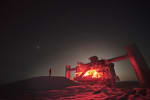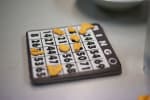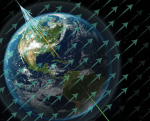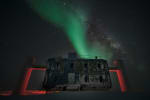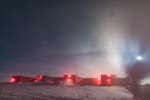It was a pretty busy time last week at the Pole. IceCube’s winterovers had some unrelated hardware incidents that required troubleshooting and fixing, and a trip out to the IceCube Lab. And look what a great photo winterover Raffaela captured on that trip, with the ICL backlit by a full moon. […]
News
WIPAC professor Stefan Westerhoff dies at 50
Stefan Westerhoff, a professor in the physics department at the University of Wisconsin–Madison, passed away on Sunday, August 5, 2018, after a long illness. He was 50. […]
Week 30 at the Pole
Last week the weather was a bit mixed, and the winterovers had their lunar eclipse viewing marred by blowing snow. Regardless, they still got together outdoors for a group photo. […]
Constraints on neutrino emission from short-lived transient sources
In a new search for neutrino sources, the IceCube Collaboration and other collaborators have looked for short-lived transient sources, including gamma-ray bursts, core-collapse supernovae, or neutron star mergers. The search, which looked for two or more neutrinos detected within 100 seconds from the same location, included transients that might not emit gamma rays and might be pointing to uncharted objects in the universe. The results submitted this week to Physical Review Letters did not identify any individual source but did show that the number of bright short-lived transient neutrino sources must be small or they must be fairly faint. […]
Week 29 at the Pole
So much ice, yet it’s no mean feat to keep a stable water supply for the folks at the South Pole. Housed in the shack shown in this image is a rodwell, which is how they get their water. Hot water is sent down a hole to a cavity deep in the ice, and a continuous flow of water is maintained to prevent the rodwell from freezing. […]
Week 28 at the Pole
There were two bingos last week at the Pole: (1) the game, where some improvising was required for the tiles, and (2) the exclamation, which was well warranted for IceCube’s recent multimessenger results. […]
IceCube neutrinos pass a test of a fundamental symmetry in nature
A new measurement of the IceCube Collaboration has put Lorentz symmetry to the test and found—yet again—that neutrinos behave as expected. The results, published in Nature Physics, are the most stringent limits to date in the neutrino sector on the existence of a Lorentz violating field. […]
Week 27 at the Pole
Last week at the Pole, the weather was perfect for starting out the second half of winter—cold but calm conditions, with some of the prettiest auroras. […]
IceCube neutrinos point to long-sought cosmic ray accelerator
Observations made by the IceCube Neutrino Observatory at the Amundsen–Scott South Pole Station and confirmed by telescopes around the globe and in Earth’s orbit have for the first time provided evidence for a known blazar as a source of high-energy neutrinos. These results are presented in two papers published this week in the journal Science. […]
Week 26 at the Pole
The 4th of July is now behind us, but this view of the South Pole station continues with the red, white, and blue theme, while the other side of the station just shows the blue sky and the white snow. These image were only possible due to a bright moon, bright enough to illuminate the tracks in the snow surface. […]
